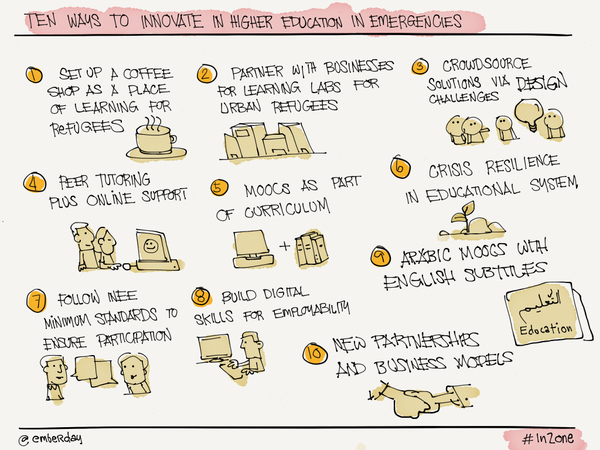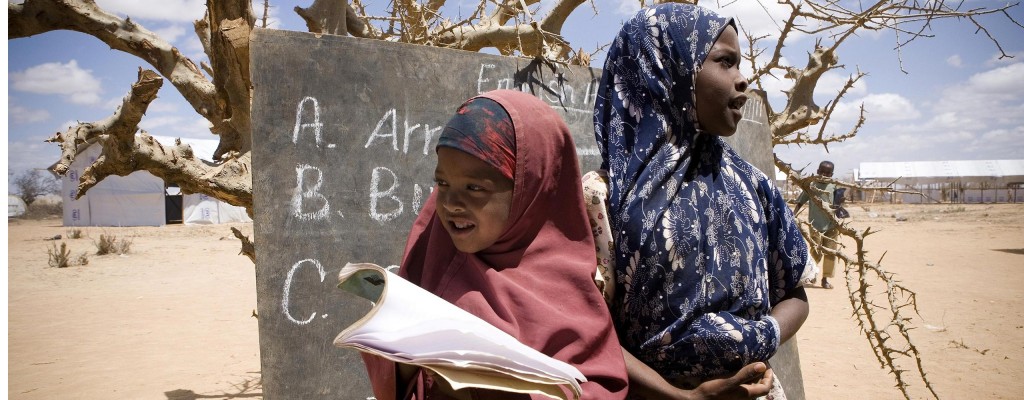In reality, education receives only 2% of humanitarian aid.
UNHCR considers education a basic right, “one that is vital in restoring hope and dignity to people driven from their homes.”
Unfortunately higher education is often a luxury for those who have been displaced. With more refugees and displaced persons than ever, we must find innovative ways to provide learning opportunities for those in emergencies.
The future security of individuals is inextricably connected to education and the transferable skills developed through schooling. The knowledge and capacities expanded through education are the building blocks of dignity that will ultimately help a person thrive.
Ita Sheehy, Senior Education Officer, UNHCR, said it best:
“We have to ask refugees what they want and they want education.”
This week InZone and UNHCR hosted a round-table on just that. A group of panelists including UNHCR Innovation Lead, Olivier Delarue; Luisa Covaria, IDEO; Dean Brooks Director, INEE; and Professor Barabara Moser-Mercer, InZone, discussed how innovation can (and must) play a role in delivering education to displaced communities.
If you missed the event, don’t worry. We’ve rounded up their top 10 ways to innovate in higher education in emergencies.

The sketch in this blogpost was created by Ed Guzman.
1. Set up a coffee shop as a place of learning for refugees
Refugees from Kakuma Refugee camp, located in the north-western region of Kenya, suggest to innovate by launching an ideal education space: a coffee shop. Creating a shared center where refugees can convene, and share their thoughts is one step in providing an engaging learning space. We hear their coffee is great as well.
2. Partner with businesses for learning labs for urban refugees
There’s a role for everyone to play in the refugee crisis. Business communities can fund greater learning access for refugees in cities. Local NGOs can then provide support for these programs on the ground and drive education through these learning labs.
3. Crowdsource solutions via design challenges
Crowdsourcing is one of the buzz-words in the humanitarian sector. It provides a unique opportunity for people across sectors, and refugees themselves, to collaborate on new solutions.
OpenIdeo is currently running a Challenge on Refugee Education. They will announce the winning top ideas next week on how we might improve education and expand learning opportunities for refugees around the world.
UNHCR Innovation has also piloted an online collaborative platform to help solve challenges that refugee and displaced communities face. Through UNHCR Ideas we’ve launched two education Challenges. The first Challenge asked the crowd how we could provide better opportunities for refugees to learn and use a new language and our second Challenge focused on providing access to education for adolescent girls.
4. Peer tutoring plus online support
Barbara Moser-Mercer highlighted the need for onsite peer tutoring coupled with virtual mentoring of refugee learners. She explained, “Learning is a social affair. People learn best in a community.”
5. MOOCs as part of curriculum
Massive open online courses is an online course aimed at unlimited participation and open access via the web. In addition to traditional course materials such as filmed lectures, readings, and problem sets, many MOOCs provide interactive user forums to support community interactions between students, professors, and teaching assistants.
MOOCs offer a unique opportunity for refugees to be provided access to distant education. InZone will be launched a multilingual MOOC: “Humanitarian Communication: The Last Mile” produced almost exclusively by refugees.
And when there isn’t access to the internet? Front load tablets with content so that refugees can continue to learn.
6. Crisis resilience in educational system
Crises send shockwaves throughout an entire education system. It’s important to invest in resilient, crisis-sensitive planning in addition to risk reduction in education systems. This also includes supporting Ministries of Education and prioritizing safety, resilience and social cohesion in planning.
7. Follow INEE minimum standards to ensure participation
The Inter-Agency Network for Education in Emergencies (INEE) promotes access to quality, safe, and relevant education for all persons affected by crisis. The minimum standards provide guidance on community participation including key actions and guidance notes. Through following their minimum standards, you can ensure you don’t “do good” badly.
8. Build digital skills for employability
The internet has opened a lot of doors for providing refugees and displaced population with transferable soft skills. Building digital skills can provide a means for online livelihoods.
9. Arabic MOOCS with English subtitles
When designing MOOCs it’s important to understand cultural sensitivity. Even more important, create MOOCs in collaboration with refugees so that you can understand their needs and wants in a course.
10. New partnerships and business models
Olivier Delarue, Lead of UNHCR Innovation, explained that “Business as usual is no longer sustainable. New solutions needed.” Through exploring new partnerships to leverage venture philanthropy and expertise from private companies, we open up the humanitarian sector to new educational models.
Did we miss a best practice in innovating for higher education in emergencies? Tell us in the comments below.
The sketch in this blogpost was created by Ed Guzman. You can follow him on Twitter and check out the rest of his amazing work here.
If you’d like to repost this article on your website, please see our reposting policy.

